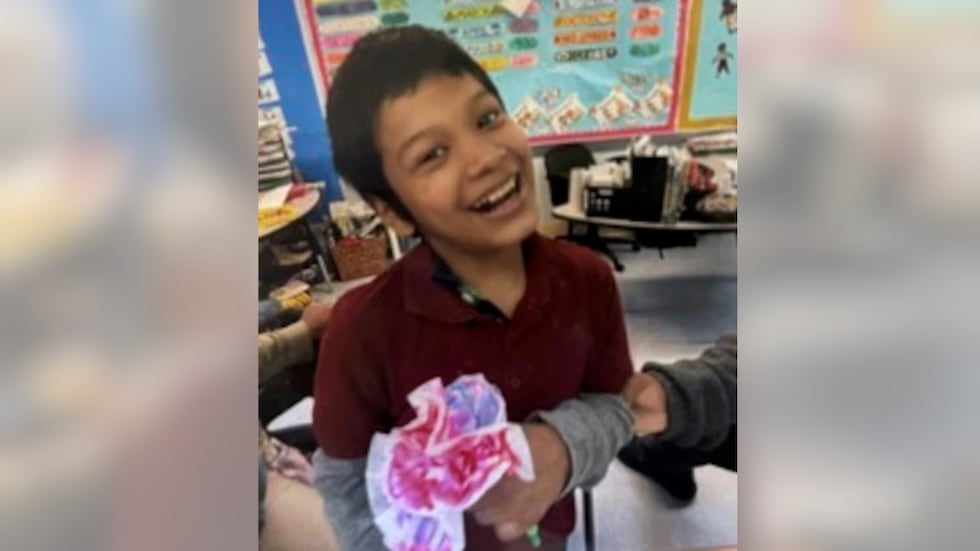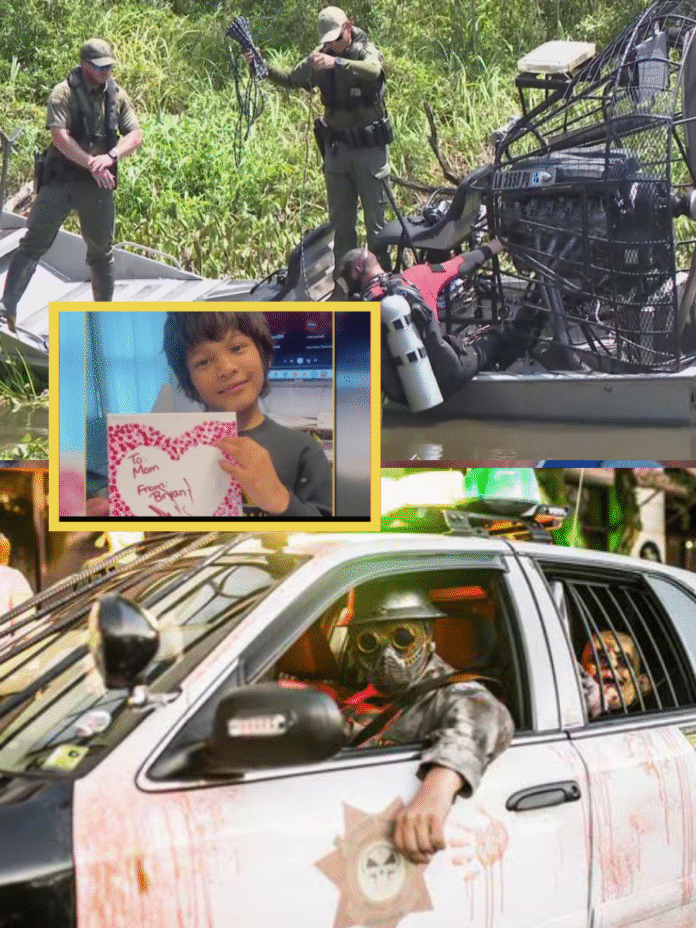This comes nearly two weeks after he was reported missing from his home.
The body of a missing 12-year-old nonverbal boy was found Tuesday morning.
According to the New Orleans Police Department, the body of Bryan Vasquez was found by volunteers searching near his home.
Vasquez, who had autism, was last seen Thursday, Aug. 14 exiting his bedroom window around 5 a.m.

Just blocks away from his home and less than an hour later, he was spotted on surveillance video only wearing an adult diaper, but there had been no sign of him since.
For nearly two weeks volunteers from different states as well as the Cajun Navy searched a body of water near his home on Beaucaire Street.
Online police records show a five hour delay between the initial call reporting Vasquez missing and when an NOPD officer responded to the call.
According to the NOPD calls for service, the initial call regarding Vasquez was made around 10 a.m. Thursday, Aug. 14.
The NOPD did not respond until 3 p.m. that day, which is five hours after the first 911 call.
A family spokesperson for the Vasquez family was critical of the response from the NOPD.
New Orleans Superintendent Anne Kirkpatrick held a news conference Tuesday stating that they still don't know what caused the delay in response.
Kirkpatrick said the investigation is still ongoing and results of that investigation will be released at a later time.
The City of New Orleans issued the following statement regarding Vasquez death:
“The City of New Orleans is deeply saddened to learn of the passing of Bryan Vasquez, a beloved child whose life, though far too short, left a lasting impression on all who knew him. Bryan was a bright, charismatic, and energetic young boy whose joy and spirit touched the lives of his family, friends, and community.
“The City also extends its gratitude to the New Orleans Police Department, the Cajun Navy, and all agencies and volunteers who came together to support the Vasquez family during this difficult time.
“Bryan’s memory will forever remain in the hearts of those who loved him, and his light will continue to shine as a reminder of resilience, innocence, and love.
“May he rest in God’s eternal peace.”
ReNEW Schools issued the following statement regarding Vasquez's death:
“The ReNEW Laurel and ReNEW Schools community is heartbroken to learn of the passing of Bryan Vasquez. Bryan was a valued member of our school family, and we are deeply saddened by this loss.

“We are grateful to the community, ReNEW staff, and the many agencies who worked tirelessly in the search for Bryan and for the compassion and support they have shown throughout this time. Our hearts and prayers remain with Bryan’s family, friends, and loved ones as they face this incredibly difficult loss. To support our community during this time, counseling and other resources will be available for our students, staff, and families.
“As we mourn, we ask for continued respect and understanding for Bryan’s family, his friends, ReNEW Laurel, and the entire ReNEW community.”
Shocking Development in the Bryan Nisenfeld Case: Drone Footage and the Missing Paper
The mysterious case of Bryan Dylan Nisenfeld, an 18-year-old freshman at Roger Williams University in Bristol, Rhode Island, who vanished on February 6, 1997, has taken a startling turn with the emergence of previously undisclosed drone footage. This new evidence, combined with the efforts of volunteers and search dogs, has reignited interest in a case that has puzzled investigators for nearly three decades. The footage reportedly shows Bryan holding what appears to be a folded piece of paper near a lagoon, but by the time rescue teams arrived, the paper was gone, deepening the enigma surrounding his death.
The Original Case: A Brief Recap
Bryan Nisenfeld was last seen leaving his literature class at Roger Williams University, appearing despondent, according to his professor. He never returned to his dorm, leaving behind his bicycle, Walkman, glasses, and guitar, with his dorm window open. His disappearance went unreported by the university for nearly a week, frustrating his family and complicating the investigation. Months later, in August 1997, a family walking along the shore of Hog Island discovered a hiking boot containing a wool sock and a severed foot, later confirmed through DNA testing to be Bryan’s. The cause of death was listed as exposure, but the discovery of his body 200 yards from his dorm, naked, with strange tracks nearby, raised suspicions of foul play.
The Drone Footage: A New Clue
Recently uncovered drone footage, purportedly from the time of the initial search in 1997, has surfaced, offering a shocking glimpse into Bryan’s final moments. The footage allegedly shows Bryan standing near the edge of a lagoon close to the university, clutching what appears to be a folded piece of paper. The grainy video, captured by an early model drone used by a local volunteer group, shows Bryan in a secluded area near the Mt. Hope Bridge, a spot he frequented to read or listen to music. The paper in his hand has sparked intense speculation: Was it a note, a map, or something else entirely?
The drone footage, while limited in clarity due to the technology of the time, places Bryan in a specific location—a lagoon near the campus—previously underexplored in the investigation. This revelation has prompted questions about why this footage was not widely publicized or thoroughly analyzed at the time. The lagoon’s proximity to where Bryan’s remains were later found suggests it could be a critical piece of the puzzle.
Volunteers and Search Dogs: Leading to the Lagoon
Following Bryan’s disappearance, volunteers, including students and local residents, joined the search effort alongside law enforcement. Search dogs, trained to detect human scent, played a significant role, reportedly leading teams directly to the edge of the lagoon where the drone footage later placed Bryan. According to accounts from the time, the dogs showed strong interest in the area, indicating that Bryan had been there recently. However, the search was hampered by the terrain and weather conditions, and no significant evidence was recovered during the initial efforts.
The convergence of the dogs’ findings and the drone footage is striking. Volunteers reported that the dogs became agitated near the lagoon, suggesting Bryan’s presence, but the search teams found no immediate trace of him or his belongings. The absence of the folded paper seen in the drone footage is particularly baffling. Was it swept away by the tide, deliberately removed, or overlooked by the search team? The missing paper has become a focal point for investigators and amateur sleuths alike, who see it as a potential key to unlocking the mystery.
Theories Surrounding the Folded Paper
The folded paper seen in the drone footage has given rise to several theories:
-
A Suicide Note: Some speculate that the paper was a note Bryan intended to leave behind, possibly explaining his intentions. His reported despondency in class and struggles with the architecture program’s workload and homesickness support this theory. However, his family firmly believes he did not take his own life, citing his close relationship with them and lack of any explicit indicators of suicidal intent.
-
A Message or Map: The paper could have been a message or map related to his activities that day. Given Bryan’s quiet nature and preference for a small circle of friends, he may have been meeting someone or exploring a specific location. The threatening phone calls he received from a former student, Josh Cohen, in the weeks prior to his disappearance add a layer of intrigue—could the paper have been connected to this individual or their interactions?
-
An Incidental Object: It’s possible the paper was unrelated to his death—a piece of litter, a class note, or a personal item that held no significant meaning. However, its prominence in the drone footage and its subsequent disappearance make this theory less likely.
-
Foul Play: The most unsettling theory is that the paper was removed by someone involved in Bryan’s death. The strange tracks found near his body, described as irregular and possibly indicating dragging, suggest another person’s presence. If the paper contained incriminating information or evidence, it could have been taken to cover up a crime.
Challenges in the Investigation
The investigation into Bryan’s death was fraught with challenges from the start. The university’s delay in notifying his family—nearly a week—allowed critical time to pass, potentially compromising evidence. The wooded area and lagoon were not immediately secured, and the strange tracks were not thoroughly documented due to limited resources and deteriorating weather conditions. The drone footage, only recently brought to light, was likely overlooked or deemed insignificant at the time, possibly due to the rudimentary nature of drone technology in 1997.
The absence of Bryan’s clothing and the folded paper further complicates the case. No trace of his clothes was ever found, and the paper’s disappearance suggests either environmental factors or deliberate interference. The lagoon’s tidal patterns could have swept the paper away, but the lack of other debris in the footage raises doubts about this explanation.
The Role of Modern Technology and Public Interest
The rediscovery of the drone footage has sparked renewed interest in the case, particularly on platforms like Reddit and X, where true crime enthusiasts have analyzed the details. Advances in forensic technology, such as enhanced image analysis, could potentially clarify the footage, identifying the paper’s contents or confirming Bryan’s actions. Ground-penetrating radar or underwater drones could also be used to search the lagoon for additional evidence, though the passage of time makes this challenging.
The Unsolved Mysteries episode that featured Bryan’s case in 2001 emphasized the strange tracks and the family’s frustration with the university’s response. The addition of the drone footage and the lagoon connection could prompt a re-examination of the case, potentially leading to new leads or witnesses. Bryan’s family continues to advocate for answers, believing that someone knows more than has been revealed.
Community and Media Impact
The emergence of the drone footage has reignited public fascination with the case. Online discussions have drawn parallels to other mysteries involving missing objects or unexplained tracks, such as the Dyatlov Pass incident, though the contexts differ. The footage has also highlighted the growing role of drones in search-and-rescue operations, as seen in recent cases like the 2025 Pensacola Beach rescue, where a drone delivered a flotation device to a drowning teenager. While drones were rudimentary in 1997, their use in Bryan’s case underscores their potential to uncover critical evidence, even decades later.
The media’s focus on the folded paper has amplified calls for the case to be reopened. Bryan’s parents, Steven and Marianne, have long criticized Roger Williams University for its handling of the situation, believing that faster action could have led to more answers. The lagoon, now a focal point, has become a symbol of the case’s unresolved questions.
Conclusion
The Bryan Nisenfeld case, already steeped in mystery, has been transformed by the shocking revelation of drone footage showing him holding a folded piece of paper near a lagoon. The efforts of volunteers and search dogs, which led straight to the lagoon’s edge, combined with the footage, suggest that this location holds critical clues. Yet, the missing paper and the strange tracks found near Bryan’s body continue to elude explanation. Was the paper a note, a map, or evidence of foul play? Did it vanish naturally, or was it taken? As technology advances and public interest persists, there is hope that these questions will one day be answered, bringing closure to a family and a community haunted by this enduring mystery. For now, the case of Bryan Nisenfeld remains a poignant reminder of how even the smallest clues—a folded piece of paper—can hold the key to unraveling the truth.
